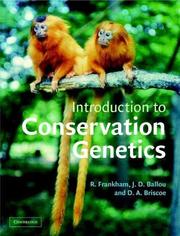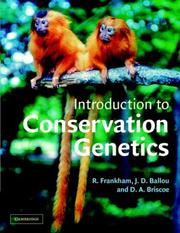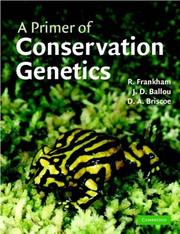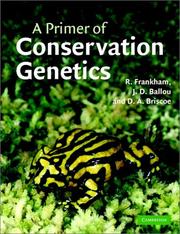| Listing 1 - 10 of 13 | << page >> |
Sort by
|

ISBN: 1107115388 0511202261 1280955856 9786610955855 0511808992 0511351364 0511077564 0511556098 0511075995 9780511077562 9780511075995 9780511808999 9781280955853 6610955859 9780511351365 0521630142 0521639859 9780521630146 9780521639859 Year: 2002 Publisher: Cambridge Cambridge university press
Abstract | Keywords | Export | Availability | Bookmark
 Loading...
Loading...Choose an application
- Reference Manager
- EndNote
- RefWorks (Direct export to RefWorks)
The biological diversity of our planet is being depleted due to the direct and indirect consequences of human activity. As the size of animal and plant populations decrease, loss of genetic diversity reduces their ability to adapt to changes in the environment, with inbreeding depression an inevitable consequence for many species. This textbook provides a clear and comprehensive introduction to the importance of genetic studies in conservation. The text is presented in an easy-to-follow format with main points and terms clearly highlighted. Each chapter concludes with a concise summary, which, together with worked examples and problems and answers, emphasise the key principles covered. Text boxes containing interesting case studies and other additional information enrich the content throughout, and over 100 beautiful pen and ink portraits of endangered species help bring the material to life.
Germplasm resources. --- Germplasm resources --- Earth & Environmental Sciences --- Ecology --- Gene resources --- Genetic resources --- Germ plasm resources --- Resources, Germplasm --- Breeding --- Genetics --- Natural resources --- Animal population --- plant population --- Biodiversity --- population structure --- population genetics --- taxonomy --- genotype environment interaction --- Molecular genetics --- Resource conservation --- genetic resources --- 574.472 --- 575.17 --- 575.17 Population genetics. Genetic processes in populations --- Population genetics. Genetic processes in populations --- 574.472 Biodiversity --- Ressources génétiques --- Evolution. Phylogeny --- General ecology and biosociology --- VARIATION (GENETICS) --- GENETICS, POPULATION --- INBREEDING --- ANIMALS, ZOO --- ANIMALS, WILD --- GENETICS
Book
ISBN: 0198783418 9780198783428 9780198783411 0198783426 Year: 2019 Publisher: Oxford: Oxford university press,
Abstract | Keywords | Export | Availability | Bookmark
 Loading...
Loading...Choose an application
- Reference Manager
- EndNote
- RefWorks (Direct export to RefWorks)
"The biological diversity of the planet is being rapidly depleted due to the direct and indirect consequences of human activity. As the size of wild animal and plant populations decreases and fragmentation increases, inbreeding reduces fitness and loss of genetic diversity reduces their ability to adapt to changes in the environment. Many small isolated populations are going extinct unnecessarily. In many cases, such populations can be genetically rescued by gene flow from another population within the species, but this is very rarely done. This book provides a practical guide to the genetic management of fragmented animal and plant populations"--
Germplasm resources conservation --- Population genetics --- Wildlife management --- Fragmented landscapes
Book
ISBN: 9780198783398 Year: 2017 Publisher: Oxford Oxford University Press
Abstract | Keywords | Export | Availability | Bookmark
 Loading...
Loading...Choose an application
- Reference Manager
- EndNote
- RefWorks (Direct export to RefWorks)

ISBN: 9780521639859 9780521630146 0521639859 0521630142 9780511808999 Year: 2002 Publisher: Cambridge Cambridge University Press
Abstract | Keywords | Export | Availability | Bookmark
 Loading...
Loading...Choose an application
- Reference Manager
- EndNote
- RefWorks (Direct export to RefWorks)
Animal population --- plant population --- Biodiversity --- population structure --- population genetics --- taxonomy --- genotype environment interaction --- Molecular genetics --- Resource conservation --- genetic resources --- Germplasm resources --- Ressources génétiques --- 574.472 --- 575.17 --- 575.17 Population genetics. Genetic processes in populations --- Population genetics. Genetic processes in populations --- 574.472 Biodiversity --- Gene resources --- Genetic resources --- Germ plasm resources --- Resources, Germplasm --- Breeding --- Genetics --- Natural resources --- Evolution. Phylogeny --- General ecology and biosociology --- Germplasm resources.

ISBN: 9780521538275 9780511817359 9780521831109 0511184875 9780511184871 0511186614 9780511186615 9780511187544 0511187548 0521831105 0521538270 1280449411 9781280449413 0511817355 0511185707 9780511185700 1107085942 9781107085947 1107148405 9781107148406 9786610449415 6610449414 0511324170 9780511324178 Year: 2004 Publisher: Cambridge, UK ; New York : Cambridge University Press,
Abstract | Keywords | Export | Availability | Bookmark
 Loading...
Loading...Choose an application
- Reference Manager
- EndNote
- RefWorks (Direct export to RefWorks)
This concise, entry level text provides an introduction to the importance of genetic studies in conservation and presents the essentials of the discipline in an easy-to-follow format, with main points and terms clearly highlighted. The authors assume only a basic knowledge of Mendelian genetics and simple statistics, making the book accessible to those with a limited background in these areas. Connections between conservation genetics and the wider field of conservation biology are interwoven throughout the book. Worked examples are provided throughout to help illustrate key equations and glossary and suggestions for further reading provide additional support for the reader. Many beautiful pen and ink portraits of endangered species are included to enhance the text. Written for short, introductory level courses in genetics, conservation genetics and conservation biology, this book will also be suitable for practising conservation biologists, zoo biologists and wildlife managers.
575 --- 575 General genetics. General cytogenetics. Immunogenetics. Evolution. Speciation. Phylogeny --- General genetics. General cytogenetics. Immunogenetics. Evolution. Speciation. Phylogeny --- Biodiversity --- Conservation biology --- Ecological genetics --- Evolutionary genetics --- Genetics --- #WPLT:ecol --- Biology --- Embryology --- Mendel's law --- Adaptation (Biology) --- Breeding --- Chromosomes --- Heredity --- Mutation (Biology) --- Variation (Biology) --- Genetic evolution --- Evolution (Biology) --- Ecology --- Nature conservation --- Biological diversification --- Biological diversity --- Biotic diversity --- Diversification, Biological --- Diversity, Biological --- Biocomplexity --- Ecological heterogeneity --- Numbers of species --- Ecological genetics. --- Genetics. --- Conservation biology. --- Biodiversity. --- Evolutionary genetics. --- Biological diversity. --- Biologia de la conservació. --- Biodiversitat. --- Genètica evolutiva. --- Evolució (Biologia) --- Genètica --- Diversitat biològica --- Diversitat ecològica --- Biologia --- Heterogeneïtat ecològica --- Conservació de recursos (Biologia) --- Ecologia --- Natura --- Protecció
Digital
ISBN: 9781402090059 Year: 2009 Publisher: Dordrecht Springer Netherlands
Abstract | Keywords | Export | Availability | Bookmark
 Loading...
Loading...Choose an application
- Reference Manager
- EndNote
- RefWorks (Direct export to RefWorks)
Evolution. Phylogeny --- Genetics --- General ecology and biosociology --- Biology --- Agriculture. Animal husbandry. Hunting. Fishery --- biodiversiteit --- biologie --- landbouw --- genetica --- Europees recht
Book
Year: 2004 Publisher: Cambridge : Cambridge University Press,
Abstract | Keywords | Export | Availability | Bookmark
 Loading...
Loading...Choose an application
- Reference Manager
- EndNote
- RefWorks (Direct export to RefWorks)

ISBN: 0521831105 0521538270 Year: 2004 Publisher: Cambridge Cambridge University press,
Abstract | Keywords | Export | Availability | Bookmark
 Loading...
Loading...Choose an application
- Reference Manager
- EndNote
- RefWorks (Direct export to RefWorks)
Ecological genetics. --- Genetics. --- Conservation biology. --- Biological diversity. --- Evolutionary genetics. --- #WPLT:ecol --- GEN Genetics & Population Genetics --- conservation genetics --- genetic diversity --- genetics --- inbreeding --- management --- populations --- taxonomy --- Biodiversity --- Conservation biology --- Ecological genetics --- Evolutionary genetics --- Genetics --- Biology --- Embryology --- Mendel's law --- Adaptation (Biology) --- Breeding --- Chromosomes --- Heredity --- Mutation (Biology) --- Variation (Biology) --- Genetic evolution --- Evolution (Biology) --- Ecology --- Nature conservation --- Biological diversification --- Biological diversity --- Biotic diversity --- Diversification, Biological --- Diversity, Biological --- Biocomplexity --- Ecological heterogeneity --- Numbers of species
Book
ISBN: 9780521702713 9780521878470 Year: 2013 Publisher: Cambridge Cambridge University Press
Abstract | Keywords | Export | Availability | Bookmark
 Loading...
Loading...Choose an application
- Reference Manager
- EndNote
- RefWorks (Direct export to RefWorks)
"This impressive author team brings the wealth of advances in conservation genetics into the new edition of this introductory text, including new chapters on Population Genomics and Genetic Issues in Introduced and Invasive Species. They continue the strong learning features for students - main points in the margin, chapter summaries, vital support with the mathematics, and further reading - and now guide the reader to software and databases. Many new references reflect the expansion of this field. With examples from mammals, birds, reptiles, fish, amphibians, plants and invertebrates, this is an ideal introduction to conservation genetics for a broad audience. The text tackles the quantitative aspects of conservation genetics, and has a host of pedagogy to support students learning the numerical side of the subject. Combined with being up-to-date, its user-friendly writing style and a first-class illustration programme, this forms a robust teaching package." --NHBS Environment Bookstore.
Germplasm resources --- Gene resources --- Genetic resources --- Germ plasm resources --- Resources, Germplasm --- Breeding --- Genetics --- Natural resources --- Evolution. Phylogeny --- General ecology and biosociology --- 575.17 --- 575.17 Population genetics. Genetic processes in populations --- Population genetics. Genetic processes in populations
Book
ISBN: 9781402090059 Year: 2009 Publisher: Dordrecht Springer Netherlands
Abstract | Keywords | Export | Availability | Bookmark
 Loading...
Loading...Choose an application
- Reference Manager
- EndNote
- RefWorks (Direct export to RefWorks)
Fitness and adaptation are fundamental characteristics of plant and animal species, enabling them to survive in their environment and to adapt to the inevitable changes in this environment. This is true for both the genetic resources of natural ecosystems as well as those used in agricultural production. Extensive genetic variation exists between varieties/breeds in a species and amongst individuals within breeds. This variation has developed over very long periods of time. A major ongoing challenge is how to best utilize this variation to meet short-term demands whilst also conserving it for longer-term possible use. Many animal breeding programs have led to increased performance for production traits but this has often been accompanied by reduced fitness. In addition, the global use of genetic resources prompts the question whether introduced genotypes are adapted to local production systems. Understanding the genetic nature of fitness and adaptation will enable us to better manage genetic resources allowing us to make efficient and sustainable decisions for the improvement or breeding of these resources. This book had an ambitious goal in bringing together a sample of the world's leading scientists in animal breeding and evolutionary genetics to exchange knowledge to advance our understanding of these vital issues.
Evolution. Phylogeny --- Genetics --- General ecology and biosociology --- Biology --- Agriculture. Animal husbandry. Hunting. Fishery --- biodiversiteit --- biologie --- landbouw --- genetica --- Europees recht
| Listing 1 - 10 of 13 | << page >> |
Sort by
|

 Search
Search Feedback
Feedback About UniCat
About UniCat  Help
Help News
News